August
16, 2020 -
Alarm in the Buckwheat
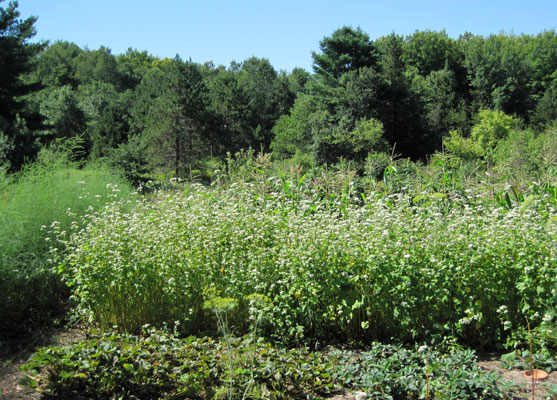 A
week or so ago I noticed the last patch of buckwheat was starting to
phase from flower to seed so it was time to cut it down. I often grow
buckwheat whenever I have an empty bed or patch for green manure or
mulch. Letting it flower allows the pollinators to enjoy it (though
they've been very sparse this year) and it's quite attractive. If I
don't cut it well before it goes to seed I end up with buckwheat "weeds"
next year. I'd already taken care of two earlier patches. (I usually do
this with the scythe but as the space was tight I tried our Greenworks
battery hedger which worked surprising well, even though I had to run it
on my knees.) A
week or so ago I noticed the last patch of buckwheat was starting to
phase from flower to seed so it was time to cut it down. I often grow
buckwheat whenever I have an empty bed or patch for green manure or
mulch. Letting it flower allows the pollinators to enjoy it (though
they've been very sparse this year) and it's quite attractive. If I
don't cut it well before it goes to seed I end up with buckwheat "weeds"
next year. I'd already taken care of two earlier patches. (I usually do
this with the scythe but as the space was tight I tried our Greenworks
battery hedger which worked surprising well, even though I had to run it
on my knees.)
So I put it on my mental list to get to this bed of buckwheat soon. But
about the same time I became aware of some persistent chipping when I
was in that area of the garden. This was more strident and intense than
the common chip-chirp of the Chipping Sparrows. Then I saw who it was -
a male Indigo Bunting was directing his chips at me from a perch on top
of the buckwheat. He didn't fly away, but moved next door to the corn,
watching me, and chitting, the whole time. The next few days it became
apparent that something serious was going on here. Not only did I often
have the male chipping at me but I realized there were alarm-chirps
coming from within the buckwheat patch. Then I saw the male and female
emerge together to perch nearby. So, no question about it now; there
will be no cutting down of the buckwheat patch, at least not for awhile.
Are they nesting in there? It seems a bit late but with the unusual
weather extremes of this year there really is no "normal" and it does
appear that they've chosen that spot for an August event of some sort.
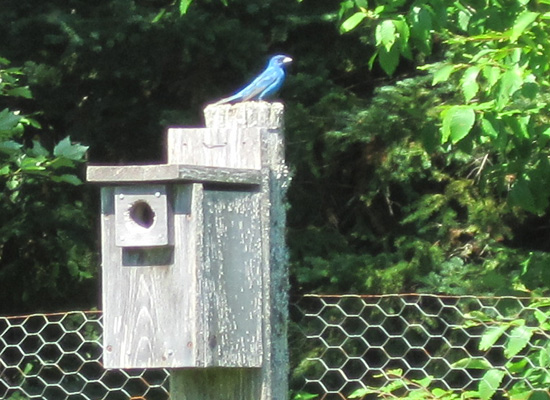 The
male is so attractive amongst the white mass of buckwheat blossoms so
when I saw him there again I ran back to the house to get the camera. He
usually sticks around for some time. But when I came back both the male
and female were off nearby fussing loudly at someone else. When I came
back into the garden the male flew over to a nearby nest box to check me
out, staying long enough for a photo op before going back to help his
partner chase off whoever else they were upset about. The
male is so attractive amongst the white mass of buckwheat blossoms so
when I saw him there again I ran back to the house to get the camera. He
usually sticks around for some time. But when I came back both the male
and female were off nearby fussing loudly at someone else. When I came
back into the garden the male flew over to a nearby nest box to check me
out, staying long enough for a photo op before going back to help his
partner chase off whoever else they were upset about.
Thankfully for their peace of mind I'm not spending a lot of time in the
garden right now. I haven't seen, or heard, the male the last few days
so maybe his guard duty has eased off, or he's decided I'm not that much
of a threat. I've heard some chirps from the buckwheat patch and have
seen the female briefly so I assume all is well. Meantime, I walk/work
gently around that area when I'm out there and wish the Indigo Buntings
the best weather for their new family.
August 1, 2019 - For Thee and the Bee
I spend a fair amount of time searching and reading, planning and planting
specifically for the pollinators, thinking that as I add more and more
fruit that I'm counting on them to pollinate I should be adding special
extras for their enjoyment and use. This is fine, and they do make use
of these gifts, but they also often remind me by their actions that they
are quite capable of taking care of themselves with what is already
there. I do know this, it's quite obvious as our homestead is blessed
with a wide and generous variety of wildflowers, and many a blossoming
tree is loud with buzzing during peak time. But our pollinator
population has definitely dropped. Only bumble bees seem to be in good
supply, or maybe they are just the most obvious. But flowers are being
pollinated, fruit and seed is being produced, nature is doing the job
that nature does. There are ups and downs in all things.
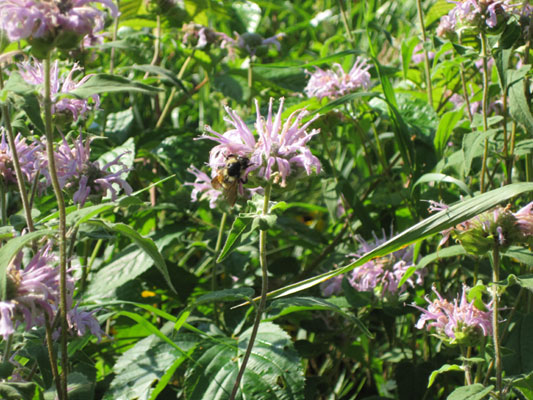 And
it is the plants that I didn't plant for the pollinators that remind me
that all is well in spite of my fussing and mild worry. The Wild
Bergamot I didn't have much hand in. Early on, maybe the late 80's, I
noticed this pretty lavender flower up by the gate at the end of our
road. I transplanted a little clump into the edge of the front yard wild
area. They have grown there ever since, expanding some though not much,
losing themselves in the surrounding vegetation until they flower and
they get their well deserved attention, from the bees and us. And
it is the plants that I didn't plant for the pollinators that remind me
that all is well in spite of my fussing and mild worry. The Wild
Bergamot I didn't have much hand in. Early on, maybe the late 80's, I
noticed this pretty lavender flower up by the gate at the end of our
road. I transplanted a little clump into the edge of the front yard wild
area. They have grown there ever since, expanding some though not much,
losing themselves in the surrounding vegetation until they flower and
they get their well deserved attention, from the bees and us.
Some years ago more Wild Bergamots showed up by the garden gate, to our
delight. We marked those few beginners so we wouldn't mow them and they
responded by spreading into a really nice patch, along with a growing
population of Black Eyed Susans, apparently enjoying each others
company. They are a pleasing welcome to the garden, loved by the bees
and other pollinators (and us), and with no assistance from me.
The
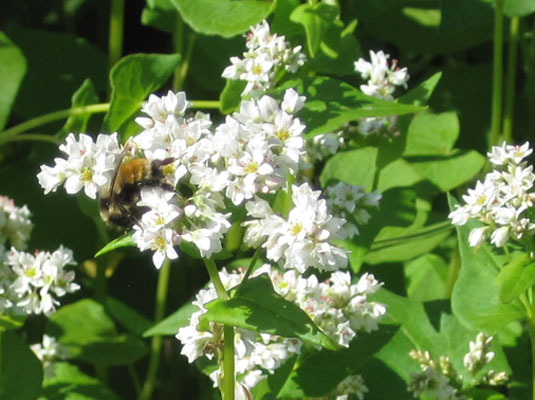 buckwheat
in the garden, on the other hand, does get my help by being planted
wherever there is a spot not being used by vegetables. Since it will
happily self seed (and does in spite of my management) in a way it
doesn't need me either. But being in the garden proper I require it to
keep in its place, though I'm pretty lax and often let volunteers grow
here and there. I initially started planting buckwheat for green manure
- to grow and be cut down for mulch and extra nutrition as it breaks
down. It grows easily and produces a lot of matter. But when it flowers
it's obvious it has an even bigger purpose - it's there for the
pollinators, and they are there for it. It is one very popular flower!
And by a variety of insects. The "fragrance" of the flowers won't win it
any awards by humans, on the contrary being downwind causes wrinkled
noses (and visitors might look quickly at their shoes to see if they
stepped in something they shouldn't have) but no matter, the prolific
buzzing coming from the patch wins all. There certainly are showier and
more touted "bee flowers" but I doubt there are many more popular to the
bees than the rather humble buckwheat. buckwheat
in the garden, on the other hand, does get my help by being planted
wherever there is a spot not being used by vegetables. Since it will
happily self seed (and does in spite of my management) in a way it
doesn't need me either. But being in the garden proper I require it to
keep in its place, though I'm pretty lax and often let volunteers grow
here and there. I initially started planting buckwheat for green manure
- to grow and be cut down for mulch and extra nutrition as it breaks
down. It grows easily and produces a lot of matter. But when it flowers
it's obvious it has an even bigger purpose - it's there for the
pollinators, and they are there for it. It is one very popular flower!
And by a variety of insects. The "fragrance" of the flowers won't win it
any awards by humans, on the contrary being downwind causes wrinkled
noses (and visitors might look quickly at their shoes to see if they
stepped in something they shouldn't have) but no matter, the prolific
buzzing coming from the patch wins all. There certainly are showier and
more touted "bee flowers" but I doubt there are many more popular to the
bees than the rather humble buckwheat.
December 3, 2018 -
Thinking Green
It's been a particularly cloudy November heading into December. Though
colder than usual the lack of sun isn't unusual for this time of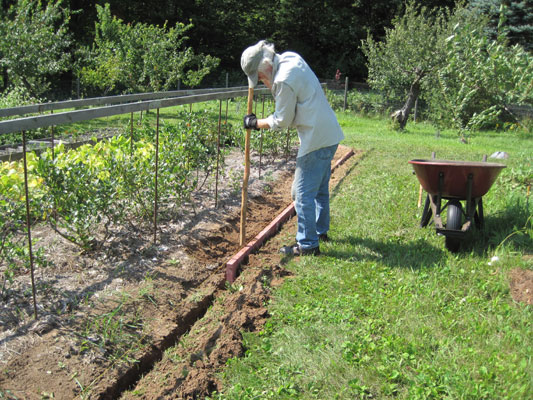 year. We get rather excited and instantly cheerful when the rare sun
does show, as it did for a good ten minutes today! Not only for spirits
but also for that fully appreciated solar boost to our batteries. We
take the days, and weather, as it comes without complaint; happy to have
some sun, happy to have some snow (even if it's only about 4" thus far),
happy to be living here. I like winter. But when I came across this
photo from a beautiful August day this summer I found myself gazing at
it overlong, melting into the feeling of that green warmth. Steve was,
of course, warmer than I was that day as he was doing the work while I
stood back and appreciated what he was doing. Mostly the garden and
orchard are my domain but he gets involved for special projects, like
this one.
year. We get rather excited and instantly cheerful when the rare sun
does show, as it did for a good ten minutes today! Not only for spirits
but also for that fully appreciated solar boost to our batteries. We
take the days, and weather, as it comes without complaint; happy to have
some sun, happy to have some snow (even if it's only about 4" thus far),
happy to be living here. I like winter. But when I came across this
photo from a beautiful August day this summer I found myself gazing at
it overlong, melting into the feeling of that green warmth. Steve was,
of course, warmer than I was that day as he was doing the work while I
stood back and appreciated what he was doing. Mostly the garden and
orchard are my domain but he gets involved for special projects, like
this one.
Several years ago I decided there had to be an easier way to keep the
surrounding vegetation out of the garden beds. We'd tried many things
over the years - mulch, carpeting, tilling, hoeing - all OK but too
temporary and not particularly satisfying. I wondered about concrete
pavers. We checked what was available in the simple and inexpensive line
and decided to try it. Steve agreed to the job (much neater than if I'd
have done it) and did the west, east and half the south borders of the
50' x 70' garden last year. It worked well and I liked it. For sure some
grass roots do find their way under but not many. I was a bit afraid it
might look too formal for my very 'down to earth' garden/orchard but it
would take more than a neat line of pavers to make this area formal.
They fit in surprisingly well. Most important, I no longer feel like I'm
fighting vegetation. My garden is a wonderfully peaceful area full of
joy. I like it that way and the pavers are helping.
This year Steve did the north border. Almost complete! He couldn't
finish the south border because the squash was growing there and
vigorously spreading out onto the surrounding vegetation, both in and
out of the garden. It was a great year for the squash! It loved the long
hot summer and made the most of it. Next year Steve will have to get the
remaining pavers in before it starts growing.
August 27, 2018 - Magic!
Our world is full of magic and magical moments which we don't always
notice, but sometimes they are so right in front of you that you can't
miss them. This was one such. A few weeks ago we saw that
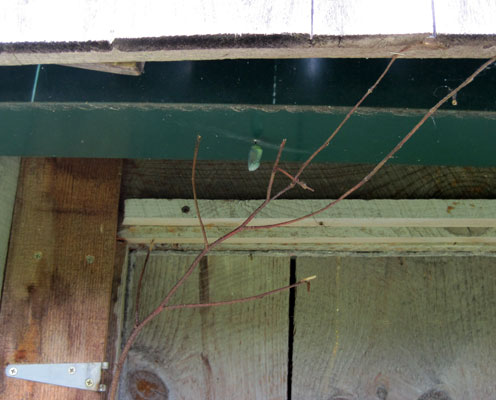 a
Monarch chrysalis had appeared on the overhead metal evestrough right
over our front door. So beautiful and delicate looking. The main door
swings in which was fine, but the screen door brushed the chrysalis as
it opened setting the pretty green decoration gently swinging. So off
came the screen door. a
Monarch chrysalis had appeared on the overhead metal evestrough right
over our front door. So beautiful and delicate looking. The main door
swings in which was fine, but the screen door brushed the chrysalis as
it opened setting the pretty green decoration gently swinging. So off
came the screen door.
We didn't know how long it would take for the butterfly to emerge but
chose not to 'look it up', just enjoy it. The last days we'd noticed the
chrysalis darkening so knew something would be happening soon. I was
concerned that there wasn't anything near by for the emerged butterfly
to grab, if it indeed needed anything. Maybe not, but I put up a small
branch just in case.
When I stepped outside before breakfast today I saw an oval spot of
monarch wing color and pattern on the side of the chrysalis. Today was
the magical day! After breakfast I carefully opened the door to find the
fully emerged beautiful butterfly holding onto its thin (but strong!)
empty case. Wow!! It was a cloudy and windy day. I'd often watched
butterflies in the garden sitting on a plant in the sun slowly working
their new wings but there was no sun today. Maybe later. But it wasn't
time to work those wings yet. Thankfully it was warm.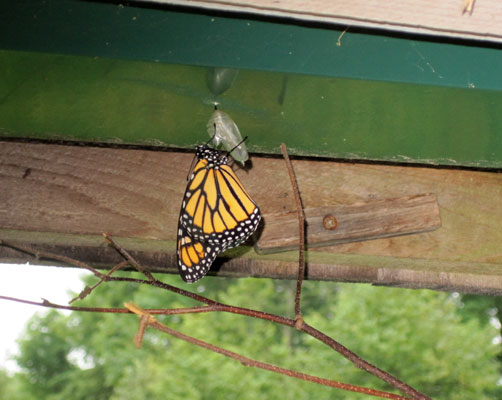
I
checked on her often during the morning as I cut up tomatoes to can. It
appeared she was trying to get a better hold as the wind rocked her back
and forth but the metal trough didn't give any purchase. So I carefully
clamped a soft plant stem beside her. She wrapped a leg around it and
settled back down. I went back inside. It was taking a long time to get
the tomatoes cut up.
Finally, tomatoes done and on the stove, I headed out to the garden to
pick lunch. Cam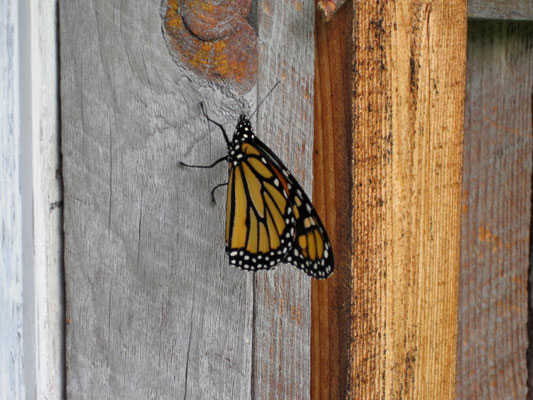 e back to find her on the wooden door frame, gently
rocked by the wind and carefully opening and closing those new wings.
Being overly concerned I saw some spider
web strands nearby and carefully removed them, getting too close for
comfort I'd guess. So off she flew, several small low circles then one
large sweep above the house and yard, and into the nearby trees. Away
from the gusty wind and away from the meddlesome woman. Wow!! doesn't
quite describe it but I was so thankful to be there to watch her first
flight. Maybe in celebration I'll pick up another late blooming on-sale
plant somewhere. A possible little treat for our beautiful flying resident(s). e back to find her on the wooden door frame, gently
rocked by the wind and carefully opening and closing those new wings.
Being overly concerned I saw some spider
web strands nearby and carefully removed them, getting too close for
comfort I'd guess. So off she flew, several small low circles then one
large sweep above the house and yard, and into the nearby trees. Away
from the gusty wind and away from the meddlesome woman. Wow!! doesn't
quite describe it but I was so thankful to be there to watch her first
flight. Maybe in celebration I'll pick up another late blooming on-sale
plant somewhere. A possible little treat for our beautiful flying resident(s).
August 18, 2018 - Wildlife Co-workers
Conversations with other gardeners tend often to veer at some point
towards the 'wildlife bandits and outlaws' -- those creatures whose
desire and search for a good meal (or maybe just a good time!) are often
in conflict with the gardener's own desires for a good harvest. Over the
years I've come to terms with all the varied wildlife we share this part
of the world with, and generally enjoy them (a good fence helps!). They
get some of ours, we get some of theirs, and overall it's a peaceful
co-existence. But this year was a bit more of a challenge, thanks to the
over-abundance (in our opinion) of voles. When the snow melted this
spring we had the most amazing network of runs in the grass that I've
ever seen (or ever hope to see again!). And I understood why we had a
Barred Owl move in and stay around all winter. It saw it often in the
garden and orchard. I thought it was because of the logging around us.
But I'm pretty sure now that it was because of the great food supply.
Thankfully, most of my trees and bushes had hardware cloth barriers so
my losses due to vole damage wasn't as bad as it could have been, and
many things have recovered/regrown over the summer. The wild shrubs,
trees, brambles - anything that could be chewed and eaten - had a great
deal of 'thinning out', too. I bought more hardware cloth and set in to
make sure ALL of my plantings are protected for this winter. I wasn't
concerned about summer months because the voles pretty much are eating
grass and such, not bark.
But then about every time I went out to the compost pile I had a vole or
two run in or out of it, almost across my feet. That was just going too
far. It was obvious they had set up a vole housing complex in my compost
pile. So I got out some wooden mouse live traps Steve had made many
years ago, and started catching voles - one almost every morning, and
I'd take what became a routine walk to a far section of our property and
release them. I certainly didn't mind the walk, but after several months
the three traps (made for indoor use) were looking pretty rough, and I
was getting tired of transporting voles (and cleaning the traps). Plus
they were eating my red ripe peppers and cherry tomatoes. It was time to
get serious about clearing this community out. I knew I wouldn't get all
voles out of the garden/orchard area (there are plenty of fields around
for new ones to move in from) but I needed to get this population down.
So soon I had 6 new purchased plastic vole/mouse live traps in place,
baited with the the best (well, cheapest) peanut butter. I was ready.
First morning - no voles. Second morning - no voles. Third, fourth. Well
this was irritating. I supposed I could have gotten them all, though
somehow I didn't think so. Maybe the didn't like the peanut butter.
Maybe they didn't like the traps. Then the fifth day I was making my
rounds checking the traps and there in the middle of the path, near one
of the traps was a small scat. Mmmm. Could it be? I came in, looked up
in our "Animal Tracks" book (which includes scat drawings), and yep,
there it was -- a weasel. A weasel had moved in and cleared out the
voles. This wasn't too much of a surprise - there had been weasel tracks
this past winter by the compost pile (along with owl wing prints). It
had simply come back for some more good eating. I hope it sticks around
this winter.
I picked up my new traps and put them away. The weasel is much better at
vole control than I am.
August 2, 2018 -- Abundance and Absence
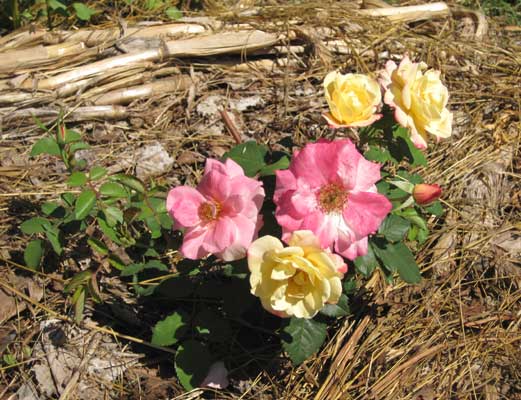 Life
is so wonderfully full, especially in the summer! There is so much going
on to share with you and so little time to do the sharing. I know we'll
catch up come winter and I expect your lives are equally full so just a
few photos and words to let you know we're still here and enjoying the
abundance of summer. Food certainly, and the garden is feeding us very
well! But there is so much more. Life
is so wonderfully full, especially in the summer! There is so much going
on to share with you and so little time to do the sharing. I know we'll
catch up come winter and I expect your lives are equally full so just a
few photos and words to let you know we're still here and enjoying the
abundance of summer. Food certainly, and the garden is feeding us very
well! But there is so much more.
Populations rise and fall naturally with the years and usually adjust
themselves without any attention from us but we do tend to mostly notice
the extremes of the peaks and valleys. Here on the homestead this past
year has been a record high for voles (and I'm sincerely hoping they are
on the downswing now -- at least in the garden and orchard. But I'm sure
there are those who are happy with the abundance, such as the resident
Barred owl, weasel, coyotes, fox, and our own LilliB.) Equally
noticeable has been the unusually low population of flying insects,
which means a low population of birds who depend on those insects for
food. We miss having so many birds -- but we haven't missed AT ALL the
usual abundance of black flys and mosquitoes. We do have birds, just not
as many. Some, like the trees swallows, simply came, checked things out,
and went elsewhere where the food was more plentiful (I'm guessing),
though they stayed around long enough to harass the bluebirds for
awhile. Some just didn't show up, like the sparrows and juncoes. Others
it seems we have just one family instead of several families - robins,
bluebirds, hummingbirds, gold finches, wrens, chickadees, indigo
buntings, catbirds, cedar waxwings, and the hard working friendly
co-gardeners Chipping Sparrows. And others. Life wouldn't be much
without the birds. I don't even mind sharing some fruit with them (well,
within reason!) (my reason, of course, not theirs).
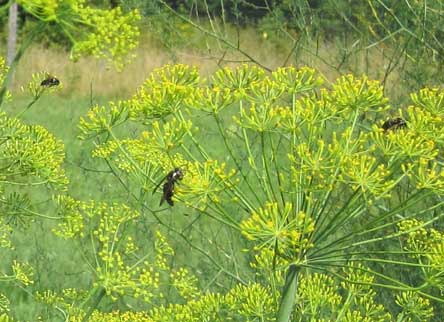 But
the other big absence has been pollinators -- the many kinds of bees,
wasps, hornets, others. And butterflies, too. Since their numbers are so
down it's a special joy to see them busily supping at the variety of
flowers this time of year. I'm happy that what I'm growing in the garden
and orchard is popular, from dill flowers to catnip, each with their own
admirers. And with much sharing between species, like the fritillary and
bee on the echinacea. Now, personally, I think the Campfire Rose (above)
is much more attractive and catches my eye every time I walk in the
garden, but I don't often see insects on those flowers.
While the very understated small hardly noticably flowered (but prolific
and quickly overgrown!) catnip is always humming with many busy bumbles
the moment the first flowers appear and is never without attendance. So
I allow too many to grow in the garden, brush by carefully as it grows
with abandon into the paths, and weed out the many progeny. But
the other big absence has been pollinators -- the many kinds of bees,
wasps, hornets, others. And butterflies, too. Since their numbers are so
down it's a special joy to see them busily supping at the variety of
flowers this time of year. I'm happy that what I'm growing in the garden
and orchard is popular, from dill flowers to catnip, each with their own
admirers. And with much sharing between species, like the fritillary and
bee on the echinacea. Now, personally, I think the Campfire Rose (above)
is much more attractive and catches my eye every time I walk in the
garden, but I don't often see insects on those flowers.
While the very understated small hardly noticably flowered (but prolific
and quickly overgrown!) catnip is always humming with many busy bumbles
the moment the first flowers appear and is never without attendance. So
I allow too many to grow in the garden, brush by carefully as it grows
with abandon into the paths, and weed out the many progeny.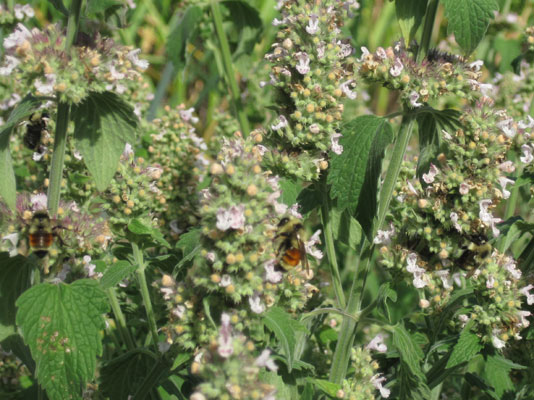
But there are also many flowers that both the pollinators and us enjoy
and I'm having a good time adding to the mix. Most are wildflowers such
as the Purple
Coneflower, and some are imports that wouldn't survive without the
gardener's help. We all enjoy them each in our own way and every time I
see a "bee" working diligently on flowers tiny or large I marvel at
their ways. It makes the flowering time of year so very special.
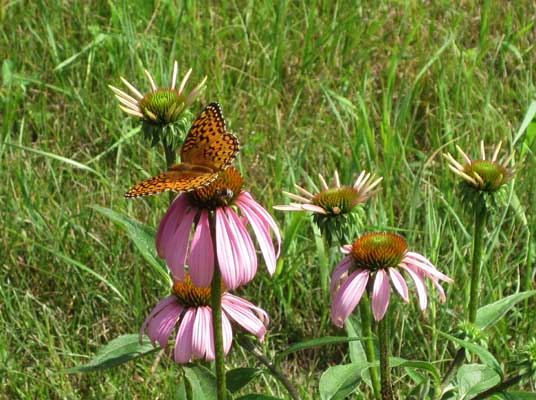
Starting Seeds - February 26, 2018
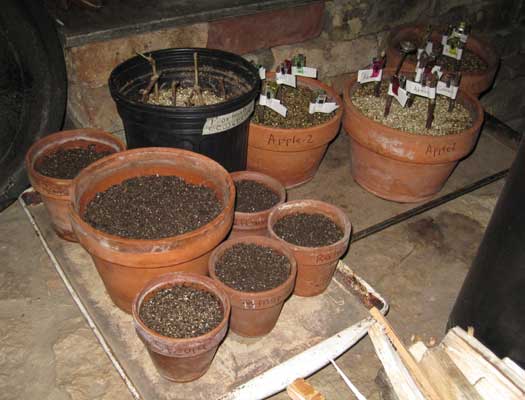 Gardening
has begun! It's a bit early, I know, but the temperatures are warming,
almost making it above freezing, and I just felt like planting something. So
I started some peppers, a little lettuce, a few cherry tomatoes for an extra
early crop, some marigolds for the same reason (the main plantings will wait
for a few more weeks), some herbs. It felt good to be messing about in the
dirt. The pots have now joined the cuttings in the warm spot behind the wood
stoves. We may still have a foot and half of snow outside but there is a
taste of spring inside! Not even counting all the greenery in the greenhouse
which is definitely perking up and growing more. I've even had a few early
rising ladybugs to transplant out there which is nice. March is only a few
days away - the inbetween month - neither winter nor spring but often both. Gardening
has begun! It's a bit early, I know, but the temperatures are warming,
almost making it above freezing, and I just felt like planting something. So
I started some peppers, a little lettuce, a few cherry tomatoes for an extra
early crop, some marigolds for the same reason (the main plantings will wait
for a few more weeks), some herbs. It felt good to be messing about in the
dirt. The pots have now joined the cuttings in the warm spot behind the wood
stoves. We may still have a foot and half of snow outside but there is a
taste of spring inside! Not even counting all the greenery in the greenhouse
which is definitely perking up and growing more. I've even had a few early
rising ladybugs to transplant out there which is nice. March is only a few
days away - the inbetween month - neither winter nor spring but often both.
MISCELLANEOUS QUESTIONS I'VE RECEIVED (and
ANSWERED)
GROWING GRAINS -- I am interested if it is
possible to grow and mill my own alternative grains (sorghum, millet, etc). Is
it possible or worth it?
In our early years on our homestead I tried growing a number of grains for flour
but found that it took a lot of space to grow enough to amount to much, and it
was quite time consuming to thresh out even the easiest grains by hand and to
winnow them clean. Grains in general aren't that hard to grow -- I think we
grew, in addition to wheat -- rye, barley, naked oats, millet (the birds loved
it), amaranth (didn't make it to maturity in our climate but it was beautiful).
But it certainly can be done. For any quantity a good grass scythe is almost a
must, though for small quantities grass shears work. Field corn is by far the
easiest grain for the homestead (if you happen to be in a short season area
Painted Mountain is a very good choice). I'd highly recommend Gene Logsdon's
book -- "Small Scale Grain Raising -- An Organic Guide to Growing, Processing
and using Nutritious Whole Grains for Home Gardeners and Local Farmers" -- which
I see has been reissued (my well worn and falling apart copy is over thirty
years old and still a wonderful resource). It's available from the Countryside
Bookstore and other sources.
SEED SAVING -- It is the gathering of seed
for next year's crop that is presenting me with problems. I find a lack of
sources of information on how to tell when plants are "going to seed" and how to
get the seed from the plant for things like Brussels sprouts, lettuces and other
greens, onions, carrots and others.
I have been saving my own seed for many years and some vegetables
are quite easy while others have more complex needs. The best source of
information I have found on home seed saving, and one I highly recommend, is the
book "Seed to Seed" by Suzanne Ashworth. I wish the book had been around when I
first started! It is a great resource and should get you going the right
direction. Some seed can be grown and saved in a small garden but many of the
crops require more space and plants. It's fun to grow what you can though.
Thankfully, good seed is available from many very good seed companies and is not
very expensive so even if you can't grow your own you can obtain good seed.
SEED SOURCE -- We have 15 or so seed
catalogues, heirloom and otherwise, but we cannot find the lettuce, tomato and
pepper seeds you mention in your article. Could you tell us where you got those
seeds? --Nancy from Canada
Seed companies change their line-up regularly so it's often hard to find a
particular variety -- this is why I save seed of my favorites, though I've found
that there are so many other good varieties available that it's not much of a
problem. Many of the varieties I grow came originally from growers listed in the
Seed Savers Exchange Yearbook and are often not available commercially. I don't
now recall exactly what I mentioned but you might try Kathleen Pluncket-Black's
"Plum Creek Seeds" -- she sells a number of varieties not generally available.
I've also had good luck with Fedco. In the past I've ordered from many of the
companies listed on my Seed Sources page (see above left menu for link) and been
happy with them. I don't order many seeds now since I grow most of my own.
PLANTING FLATS -- What
is the bottom of your planter? Plywood? Do you drill holes? Maybe a screen
bottom? --Beverly
What you use to make the bottom of the flats. If it is wood as I assume it
is, is it all one piece such as plywood (which I would think would rot quickly)
or is it several boards that are adjoined??--Bob
Yes, the flats are homemade, and I've used both solid wood and plywood for the
bottoms. I drill maybe 8 holes for drainage but they are as likely to drain out
the edges as out the holes. They both work and do rot out eventually. If the
sides are still good, I just replace the bottoms. I usually put a layer of
newspaper on the bottom before adding the dirt which I think helps them last
longer. Here is a description from the Greenhouse article in the March 2010
issue of "Countryside Magazine":
Flats are easily made of scrap wood of whatever type
is available (not painted or stained with toxic coatings, of course). My basic
flat is about 11" x l6" x 3 1/2" (inside measurement) made of 3/4" boards with
holes drilled in the bottom for drainage. Bottoms set in grooves in the lower
edge of the side pieces are strongest (particularly if you use plywood for your
bottom), but you can also fit the bottom boards flush inside the box or in
rabbets and nail or screw in from the sides. Pine is my favorite and lasts
longer than poplar, but if that is what you have it works fine. Hardwood is OK
too, but it is heavier. Drywall screws work well for fasteners if your wood is
apt to warp but nails are usually quite adequate. The flats can be as plain or
fancy as you want, the plants won’t care. It’s nice to make them a size that
best utilizes the bench space you have. I’ve made smaller and larger flats. But
larger ones (15” x 18” x 5”) filled with dirt are heavy and hard to move around
and haul out to the garden, and smaller ones aren’t quite as useful.
POTATO SEED -- I have been planting certified
seed potatoes in containers for about three years. I have a couple of plants
with some seed-bearing fruit. I would like to try planting these seeds to see
what varieties turn up. How and when do I harvest the seeds? And how do Ikeep
them until next spring when they will be planted? --Jan from
Alaska
It's fairly easy to harvest and save potato seed. Let the seed balls ripen --
they will turn from green to a pale tan or whitish, from hard to soft, not
unlike tomatoes. Mash them up together in a container such as a glass to
ferment. you may have to add a little water since they tend to be quite dry. Let
them ferment about three days, stirring once or twice a day. They will develop a
mold and probably smell (I don't remember on the potato seed but I know tomatoe
seeds fermenting do). The fermenting apparently destroys some possible diseases
and it breaks down the sac around the seed.
The seed is small so you'll need a tea strainer (or a
cloth would do). To clean, fill your glass with water, let the seeds settle,
then pour off the water and remnants on top. Do this as many times as necessary
till you have clean seed. Then strain and spread out on a saucer to dry. This is
the same process as for tomato seed. when the seed is dry, put in an envelope
and store in a cook, dry place. It's nice to keep track of the ancestry -- both
the type potatoe the seed came from and any other varieties grown that year
since potatoes cross pollinate. But even if you only grew one variety, the seed
will likely not come true to the parent. which is one reason it's not done
commercially.
In the spring you need to start your potatoes inside
early just as you would tomatoes. Plant the seedlings outside after danger of
frost, then let them grow. The first year you will probably harvest only tiny
tubers, and each plant will be different. Save the tubers from the most
promising plants (health, yield and taste) and plant them next year just as you
do regular potatos. In another year or two they will be growing regular full
size tubers. If you find a good one, keep growing and saving tubers. If it
continues to be a worthwhile variety, name it and keep it going!
Out of 24 plants I planted two different years, after
many years of selection, I only continued to grow two. They were particularly
free of blight which was great and the somewhat scab resistant which is
important to me. But the taste never came around (they tended to be bitter) and
I finally gave them up. But I'll do it again one of these days -- it was fun and
there is always that possibility of finding a great variety!
QUEEN ANNES LACE FLOWERS -- Is the
Queen Anne`s Lace you speak of the same as the dried version they use in flower
arrangements? I love the smell, and have been trying to find some to grow and
dry for my own use. None of the seed catalogs I get have it listed. Maybe it is
not a good thing to have around. --Ila from central
Idaho
I assume it would be the same though I don't
really know. Queen Anne's Lace is a wild plant but there might likely be a tamed
version that is grown for the cut flower/dried flower trade. But you could just
grow carrot flowers and dry them the same way (they are basically the same
plant) if you can't find wild plants around to harvest seed from. It may be
considered an "invasive plant" in some areas, but if you cut the flowers you
won't have to worry about them reseeding. You could check with your local
cooperative extension office. If you are in zone 4 you shouldn’t have trouble
growing carrot seed (I'm actually in zone 3 -- last frost often middle of June,
first one first to mid September, though individual years vary a lot). They are
a beautiful flower whether called carrots or Queen Anne's Lace, wild or dried.
CAT GRASS SAVER -- When I
mentioned in an article my cats lounging in (and flattening) the flat of grass I
plant for them for winter grazing, Dave from Michigan sent his solution which
works great:
He staples a piece of hardware cloth on the top of
the flat; the grass grows up through but when the cats walk and lay down on the
grass the plants are somewhat protected and survive much better. I happened to
have a piece of hardware cloth in a frame (which is usually used on the vent
between greenhouse and house when I want to keep the cats out of the
greenhouse). I set it on the cat-grass-flat and the cats were able to graze at
will but weren't inclined to lounge on it, thereby making the grass (actually
mixed grains) much happier and healthier.
TOMATO RACKS -- Are the tomato
supports in the photo permanent or do they move with your tomatoes?
-- Heather in New Windsor
I do usually plant my tomatoes in the same plot each year but the wooden racks
are portable. I often change my mind about what I want where, plus the tomatoes
start the season in cold frames. When the frosts seem to be over (or the
tomatoes are outgrowing the cold frames) they come off and the rack goes on.
It's a simple affair made of wood we had on hand and suits the semi-determinant
tomatoes I grow. [see photos above]
ROTATING CROPS -- I've always read
that you should rotate crops but in your article you indicate you don't. Why
not? -- Karen
As in so many cases, I think there is some truth to the idea of rotating in some
cases but it got repeated again and again until it became a hard rule for all
with little questioning of why. It's been my experience that insects are very
capable of moving from one row to another to get to their favorites! Nature only
"rotates" occasionally and the trees, plants, bushes generally live a healthy
life, building up their own balanced ecosystems and that is what I strive to
imitate in my garden. There ARE times when I rotate, usually for convenience of
fitting the pieces of my plantings together (I'm always changing something),
sometimes for weed control (putting thickly mulched crops such as potatoes or
tomatoes in a weedy spot to clean up that area), and occasionally for a problem
such as root maggots in carrots. Though I'm not sure location matters as much as
timing. My tomatoes the last few years have died rather early of blight (though
the tomatoes also ripened early because of that so this may not be a "problem"
in my very short season!) so I'm thinking of changing the tomato and bean plots.
Maybe that will help.
The one pest I consistently have is potato bugs, and blight, and after 30
years of growing potatoes, rotating and not, I have to say it makes not any
difference. Some years there are a lot, and some years there are few with no
reason that I can see (though I'm sure they understand it). This year I planted
potatoes in the same spot and had the fewest potato bugs ever. Our neighbor
(next 80 over) also planted in the same potato area and he had more potato bugs
than he'd ever seen before. Gardening is ever changing even if one never changes
what and where you plant.
As always, I fall back on experiment and experience -- my own that is. Rules
are never ever the same for all, but there are enough similarities that it makes
sharing fun and gives one a place to start.
POTATO HARVEST -- I
planted potatoes in my garden and they are growing but when do I
harvest them? -- Mary
Potatoes can be dug to eat whenever they are a size you want to eat them. If you
are careful you can dig around with your hand to pull out a few of the
larger ones and leave the smaller ones to continue growing, usually about the
time the plant is flowering. For storage they are dug after frost in fall after
the plants have died down and the skins on the potatoes have firmed up (can't be
easily rubbed off).
PUMPKIN SEED DRYING -- I'm interested in drying/saving
pumpkin seeds for next years planting. Is this covered in your web site? Unable
to locate it there and wish you might suggest a procedure.
--Tom from Michigan
For squash/pumpkin seeds I just cut the fruit and scoop out the inner pulp when
I'm ready to cook the squash, pick out the seeds and dry them on a plate. They
are one of the easier seeds to harvest. A great book on seed saving is Suzanne
Ashworth's "Seed to Seed" if you want to do more in that area. For summer squash
let the fruit grow to mature size in the garden then hold for at least a few
weeks after frost. I have a half dozen hunker mature zucchini sitting in our
entryway that I need to get the seed out soon and the fruit to the compost pile
(and off the entry floor) before they rot. They make a pretty odd looking
'welcome' to visitors! But since they're not food they tend to get left to last.
GARDEN SIZE -- My husband and I are selling
our home in NH and looking for a few acres and a small house in Maine where we
plan to raise as much of our food as possible. I have previously grown, canned
and frozen food for winter consumption, but that was some many years ago and
really wasn't enough to be considered self-sufficient. Is there a simple way to
size a vegetable garden for two people other than actually trying to figure
yield per plant, etc.,? If there is a general rule of thumb, i'd love to hear
it. --Linda, moving from New Hampshire to Maine
I'm afraid I don't have any quick and easy way to plan the size of your garden.
It so much depends on individual likes and dislikes, crops and varieties grown,
weather, environment, etc. Our garden has changed many, many times over the
years, adjusting and adapting to our changing interests, and I'm sure will
continue to change as we do. We've progressed to eating direct as much as
possible out of the garden, or out of the root cellar in the winter, which saves
a lot of time. And I like that. Our meals change as the crops do. One of the
biggest differences over the years in how much I needed to grow, or buy, was how
much one or the other of us was home (or gone -- working out). I raise a lot of
what we eat, but also buy grains and raisins and oil and such. And apples in the
fall when our trees are on their off years. In the early years we bought more
and now we buy less.
A garden seems to naturally grow as you do and you’ll learn what you like to eat
and what you don’t and how much. But no matter how much you plan and organize
nature does what nature does, and each year I find I have more of this, less of
that. We adapt our eating to the harvest and make use of the Food Coop for big
differences (such as the coons getting all the corn, or an unexpected summer
freeze wiping out the tomatoes). The biggest help for me over the years has been
a garden notebook and a food inventory notebook.
COMFREY FLOWERS, LEAVES -- Should I cut the
flower stalks of my comfrey plants (which are growing very well!), and how can I
use the leaves? --Sandy
You don't have to cut the flowers off the plants -- they are quite hardy and you
really don't have to pamper them at all. You can use the leaves for whatever you
want to -- tea, animal feed, healing, mulch. It's a wonderfully versatile plant.
HEIRLOOM PEPPER VARIETIES
I only grew Vinedale a few years as I found another that did better in my garden
(Georgescu -- a vigorous plant, large blocky yellow from NJ CA J), and I didn't
maintain the Vinedale. Meantime, I've tried a number of peppers since as I
continually had some rot in the Geogescu's (but they did well other than that).
I found two that were more reliable here -- Sunshine (large green variable bell
and non-bell with a thinner wall, turns yellow-orange early) (IN BL S '00); and
Red Belgium (earliest, thick walled, mild, light yellow non-bell, smaller plant,
turns bright red) (MI FL J '00). Getting some rot in Sunshine as well, so I've
decided to stick with Red Belgium. I also occasionally grow a hot pepper that
came originally from Johnny's many years ago, since dropped -- Caliente Hot
Pepper. You have reminded me how much I enjoy the "other part" -- experimenting
with varieties, searching out the histories and stories behind them, and the
sharing.
Copyright © Susan Robishaw
|
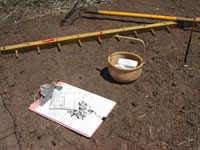


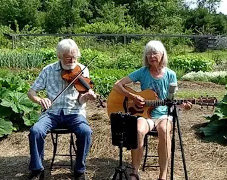
 A
week or so ago I noticed the last patch of buckwheat was starting to
phase from flower to seed so it was time to cut it down. I often grow
buckwheat whenever I have an empty bed or patch for green manure or
mulch. Letting it flower allows the pollinators to enjoy it (though
they've been very sparse this year) and it's quite attractive. If I
don't cut it well before it goes to seed I end up with buckwheat "weeds"
next year. I'd already taken care of two earlier patches. (I usually do
this with the scythe but as the space was tight I tried our Greenworks
battery hedger which worked surprising well, even though I had to run it
on my knees.)
A
week or so ago I noticed the last patch of buckwheat was starting to
phase from flower to seed so it was time to cut it down. I often grow
buckwheat whenever I have an empty bed or patch for green manure or
mulch. Letting it flower allows the pollinators to enjoy it (though
they've been very sparse this year) and it's quite attractive. If I
don't cut it well before it goes to seed I end up with buckwheat "weeds"
next year. I'd already taken care of two earlier patches. (I usually do
this with the scythe but as the space was tight I tried our Greenworks
battery hedger which worked surprising well, even though I had to run it
on my knees.) The
male is so attractive amongst the white mass of buckwheat blossoms so
when I saw him there again I ran back to the house to get the camera. He
usually sticks around for some time. But when I came back both the male
and female were off nearby fussing loudly at someone else. When I came
back into the garden the male flew over to a nearby nest box to check me
out, staying long enough for a photo op before going back to help his
partner chase off whoever else they were upset about.
The
male is so attractive amongst the white mass of buckwheat blossoms so
when I saw him there again I ran back to the house to get the camera. He
usually sticks around for some time. But when I came back both the male
and female were off nearby fussing loudly at someone else. When I came
back into the garden the male flew over to a nearby nest box to check me
out, staying long enough for a photo op before going back to help his
partner chase off whoever else they were upset about.  And
it is the plants that I didn't plant for the pollinators that remind me
that all is well in spite of my fussing and mild worry. The Wild
Bergamot I didn't have much hand in. Early on, maybe the late 80's, I
noticed this pretty lavender flower up by the gate at the end of our
road. I transplanted a little clump into the edge of the front yard wild
area. They have grown there ever since, expanding some though not much,
losing themselves in the surrounding vegetation until they flower and
they get their well deserved attention, from the bees and us.
And
it is the plants that I didn't plant for the pollinators that remind me
that all is well in spite of my fussing and mild worry. The Wild
Bergamot I didn't have much hand in. Early on, maybe the late 80's, I
noticed this pretty lavender flower up by the gate at the end of our
road. I transplanted a little clump into the edge of the front yard wild
area. They have grown there ever since, expanding some though not much,
losing themselves in the surrounding vegetation until they flower and
they get their well deserved attention, from the bees and us. buckwheat
in the garden, on the other hand, does get my help by being planted
wherever there is a spot not being used by vegetables. Since it will
happily self seed (and does in spite of my management) in a way it
doesn't need me either. But being in the garden proper I require it to
keep in its place, though I'm pretty lax and often let volunteers grow
here and there. I initially started planting buckwheat for green manure
- to grow and be cut down for mulch and extra nutrition as it breaks
down. It grows easily and produces a lot of matter. But when it flowers
it's obvious it has an even bigger purpose - it's there for the
pollinators, and they are there for it. It is one very popular flower!
And by a variety of insects. The "fragrance" of the flowers won't win it
any awards by humans, on the contrary being downwind causes wrinkled
noses (and visitors might look quickly at their shoes to see if they
stepped in something they shouldn't have) but no matter, the prolific
buzzing coming from the patch wins all. There certainly are showier and
more touted "bee flowers" but I doubt there are many more popular to the
bees than the rather humble buckwheat.
buckwheat
in the garden, on the other hand, does get my help by being planted
wherever there is a spot not being used by vegetables. Since it will
happily self seed (and does in spite of my management) in a way it
doesn't need me either. But being in the garden proper I require it to
keep in its place, though I'm pretty lax and often let volunteers grow
here and there. I initially started planting buckwheat for green manure
- to grow and be cut down for mulch and extra nutrition as it breaks
down. It grows easily and produces a lot of matter. But when it flowers
it's obvious it has an even bigger purpose - it's there for the
pollinators, and they are there for it. It is one very popular flower!
And by a variety of insects. The "fragrance" of the flowers won't win it
any awards by humans, on the contrary being downwind causes wrinkled
noses (and visitors might look quickly at their shoes to see if they
stepped in something they shouldn't have) but no matter, the prolific
buzzing coming from the patch wins all. There certainly are showier and
more touted "bee flowers" but I doubt there are many more popular to the
bees than the rather humble buckwheat.
 year. We get rather excited and instantly cheerful when the rare sun
does show, as it did for a good ten minutes today! Not only for spirits
but also for that fully appreciated solar boost to our batteries. We
take the days, and weather, as it comes without complaint; happy to have
some sun, happy to have some snow (even if it's only about 4" thus far),
happy to be living here. I like winter. But when I came across this
photo from a beautiful August day this summer I found myself gazing at
it overlong, melting into the feeling of that green warmth. Steve was,
of course, warmer than I was that day as he was doing the work while I
stood back and appreciated what he was doing. Mostly the garden and
orchard are my domain but he gets involved for special projects, like
this one.
year. We get rather excited and instantly cheerful when the rare sun
does show, as it did for a good ten minutes today! Not only for spirits
but also for that fully appreciated solar boost to our batteries. We
take the days, and weather, as it comes without complaint; happy to have
some sun, happy to have some snow (even if it's only about 4" thus far),
happy to be living here. I like winter. But when I came across this
photo from a beautiful August day this summer I found myself gazing at
it overlong, melting into the feeling of that green warmth. Steve was,
of course, warmer than I was that day as he was doing the work while I
stood back and appreciated what he was doing. Mostly the garden and
orchard are my domain but he gets involved for special projects, like
this one. a
Monarch chrysalis had appeared on the overhead metal evestrough right
over our front door. So beautiful and delicate looking. The main door
swings in which was fine, but the screen door brushed the chrysalis as
it opened setting the pretty green decoration gently swinging. So off
came the screen door.
a
Monarch chrysalis had appeared on the overhead metal evestrough right
over our front door. So beautiful and delicate looking. The main door
swings in which was fine, but the screen door brushed the chrysalis as
it opened setting the pretty green decoration gently swinging. So off
came the screen door. 
 e back to find her on the wooden door frame, gently
rocked by the wind and carefully opening and closing those new wings.
Being overly concerned I saw some spider
web strands nearby and carefully removed them, getting too close for
comfort I'd guess. So off she flew, several small low circles then one
large sweep above the house and yard, and into the nearby trees. Away
from the gusty wind and away from the meddlesome woman. Wow!! doesn't
quite describe it but I was so thankful to be there to watch her first
flight. Maybe in celebration I'll pick up another late blooming on-sale
plant somewhere. A possible little treat for our beautiful flying resident(s).
e back to find her on the wooden door frame, gently
rocked by the wind and carefully opening and closing those new wings.
Being overly concerned I saw some spider
web strands nearby and carefully removed them, getting too close for
comfort I'd guess. So off she flew, several small low circles then one
large sweep above the house and yard, and into the nearby trees. Away
from the gusty wind and away from the meddlesome woman. Wow!! doesn't
quite describe it but I was so thankful to be there to watch her first
flight. Maybe in celebration I'll pick up another late blooming on-sale
plant somewhere. A possible little treat for our beautiful flying resident(s).
 Life
is so wonderfully full, especially in the summer! There is so much going
on to share with you and so little time to do the sharing. I know we'll
catch up come winter and I expect your lives are equally full so just a
few photos and words to let you know we're still here and enjoying the
abundance of summer. Food certainly, and the garden is feeding us very
well! But there is so much more.
Life
is so wonderfully full, especially in the summer! There is so much going
on to share with you and so little time to do the sharing. I know we'll
catch up come winter and I expect your lives are equally full so just a
few photos and words to let you know we're still here and enjoying the
abundance of summer. Food certainly, and the garden is feeding us very
well! But there is so much more. But
the other big absence has been pollinators -- the many kinds of bees,
wasps, hornets, others. And butterflies, too. Since their numbers are so
down it's a special joy to see them busily supping at the variety of
flowers this time of year. I'm happy that what I'm growing in the garden
and orchard is popular, from dill flowers to catnip, each with their own
admirers. And with much sharing between species, like the fritillary and
bee on the echinacea. Now, personally, I think the Campfire Rose (above)
is much more attractive and catches my eye every time I walk in the
garden, but I don't often see insects on those flowers.
While the very understated small hardly noticably flowered (but prolific
and quickly overgrown!) catnip is always humming with many busy bumbles
the moment the first flowers appear and is never without attendance. So
I allow too many to grow in the garden, brush by carefully as it grows
with abandon into the paths, and weed out the many progeny.
But
the other big absence has been pollinators -- the many kinds of bees,
wasps, hornets, others. And butterflies, too. Since their numbers are so
down it's a special joy to see them busily supping at the variety of
flowers this time of year. I'm happy that what I'm growing in the garden
and orchard is popular, from dill flowers to catnip, each with their own
admirers. And with much sharing between species, like the fritillary and
bee on the echinacea. Now, personally, I think the Campfire Rose (above)
is much more attractive and catches my eye every time I walk in the
garden, but I don't often see insects on those flowers.
While the very understated small hardly noticably flowered (but prolific
and quickly overgrown!) catnip is always humming with many busy bumbles
the moment the first flowers appear and is never without attendance. So
I allow too many to grow in the garden, brush by carefully as it grows
with abandon into the paths, and weed out the many progeny.

 Gardening
has begun! It's a bit early, I know, but the temperatures are warming,
almost making it above freezing, and I just felt like planting something. So
I started some peppers, a little lettuce, a few cherry tomatoes for an extra
early crop, some marigolds for the same reason (the main plantings will wait
for a few more weeks), some herbs. It felt good to be messing about in the
dirt. The pots have now joined the cuttings in the warm spot behind the wood
stoves. We may still have a foot and half of snow outside but there is a
taste of spring inside! Not even counting all the greenery in the greenhouse
which is definitely perking up and growing more. I've even had a few early
rising ladybugs to transplant out there which is nice. March is only a few
days away - the inbetween month - neither winter nor spring but often both.
Gardening
has begun! It's a bit early, I know, but the temperatures are warming,
almost making it above freezing, and I just felt like planting something. So
I started some peppers, a little lettuce, a few cherry tomatoes for an extra
early crop, some marigolds for the same reason (the main plantings will wait
for a few more weeks), some herbs. It felt good to be messing about in the
dirt. The pots have now joined the cuttings in the warm spot behind the wood
stoves. We may still have a foot and half of snow outside but there is a
taste of spring inside! Not even counting all the greenery in the greenhouse
which is definitely perking up and growing more. I've even had a few early
rising ladybugs to transplant out there which is nice. March is only a few
days away - the inbetween month - neither winter nor spring but often both.